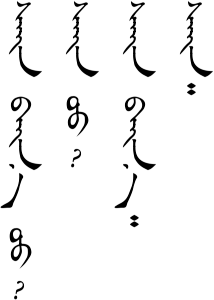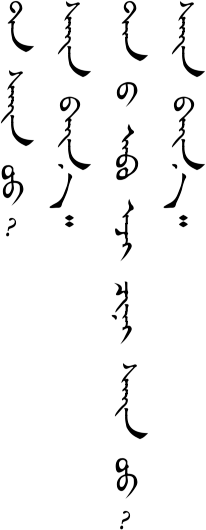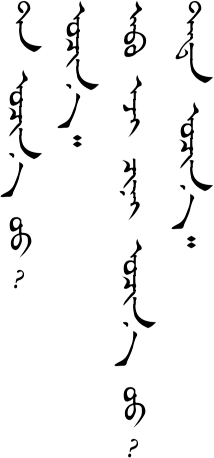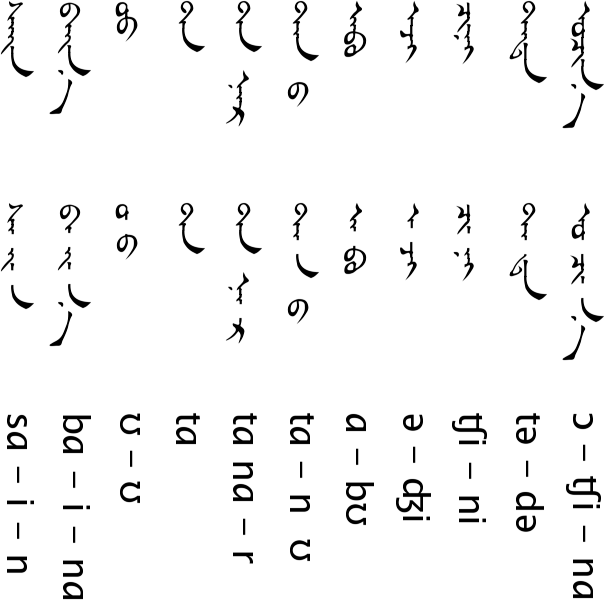Lesson 1
Suggested Study Method
Besides the key sentences, most of the dialogs below do not have English translations. Don’t let that scare you off. Listen to the dialog first and then find the new words in the vocabulary section towards the end of the lesson. Then go back to the dialog and listen again. The word order will be different than English, but you should be able to figure out the meaning. If you really can’t figure it out, then ask me in the comment area at the bottom of this page. Also leave a comment if you find (or think you have found) a mistake. I’m sure there are a few!
After you get through the lesson, then try to say the words and sentences that are in the practice section. If you have trouble with them then go back to the section of the lesson that talks about it. Some of the practice sentences require you to make new combinations that were not precisely in the lesson. Do your best to guess how you would say it. If you are unsure then leave a comment.
Review is very important for retaining what you have learned. At the very end of the lesson there is a place to download the audio for the whole lesson. Listen to old lessons throughout the day while you are doing other things. Don’t just listen mindlessly, but actively think about the meaning of what you are hearing. There is also a great flashcard program called Anki that uses spaced repetition to review and teach vocabulary. When I finish making some decks I will put them up so that you can use them, too.
Key Sentences
| sæːn bæːn ʊː? | How are you? | |
| sæːn ʊː? | How are you? | |
| sæːn bæːnɑː. | I’m doing well. | |
| sæːn. | Good. | |
Dialogs
One
A: sæːn bæːn ʊː?
B: sæn. tɑ sæːn bæn ʊː?
Two
A: sæːn ʊ?
B: sæːn. sæːn ʊː?
| Notes |
| “sæːn bæːn ʊː?” literally means “Are you well?” It is the most common way to greet someone in Mongolian. It is like saying, “Hello,” or, “Hi. How’s it going?” in English. |
| The subject (you) is commonly omitted. However, B in Dialog 1 adds it. “tɑ” is the polite way to say “you”. Since we are just beginning, we will error on the side of politeness by using “tɑ” in most of our dialogs. |
| If it appears that the IPA symbols in the dialogs are not displaying correctly, you may need to install a Unicode font on your computer. You can get directions here. If the traditional (vertical script) Mongolian does not display you may need to update your browser to a version that supports svg images. |
Substitution
________ sæːn ʊː?
|
Expansion
One
tɑː sæːn ʊː?
sæːn bæːnɑː
tɑːnæː ɑːb əːʤ ʧin sæːn ʊː?
sæːn bæːnɑː
Two
tɑ ɔʧn ʊː?
ɔʧnɔː
ɑːb əːʤ ʧin ɔʧn ʊː?
təd ɔʧnɔː
| Notes: |
| The subject pronouns (I, you, your, they) are optional when they are understood. |
Vocabulary
| sæːn | good | |
| bæːnɑː | have, be | |
| ʊː | question particle | |
| tɑː | you (polite) | |
| tɑːnə̌r | you (plural) (That’s “y’all” for all y’all Texans out there.) |
|
| tɑːnæː | your (polite) | |
| ɑːb | father | |
| əːʤ | mother | |
| ʧin | your | |
| təd | they | |
| ɔʧnɔː | go |
Practice
How do you say the following words:
- good
- father
- go
- mother
- you
- they
- your
How do you say the following sentences:
- Hello.
- How are you?
- I’m fine.
- How are your parents?
- They’re doing well.
- Are you going?
- Are your father and mother going?
If you were able to say most of these things correctly then you are ready to go on to lesson two. If not, then keep practicing! You can also download the audio for the whole lesson so that you can practice listening while driving to work. Just right-click the link below and choose “Save Link As…” to download.
Main lesson 1

If you have any questions about this lesson or if you notice a mistake, then please leave a comment below. If I don’t know the answer myself, then I will ask our teachers.







Great website!
I have been studying the Khalkha dialect of the country of Mongolia, and I’m struck by the degree of similarity. The vowels have shifted a bit, but the difference between the two seems less than that of American and British English pronunciations.
Definitely. When choosing the standard language for Mongolian, the Chinese chose Xulun Hoh, which is among the closest to Khalkha dialect. Other Inner Mongolian dialects, such as Horqin, which the vast majority of Mongolian speakers in China speak, have a greater level of vowel shift. Khalkha, however, possesses a more intense i->ya vowel shift than most other Mongolian dialects.
section”Suggested Study Method”
phrase2 line3,”Do you best”->”Do your best”
😉
Thank you for catching the typo. I just fixed it.
I welcome more people to tell me whenever they find mistakes. That saves me time in having to recheck things myself and also creates less distractions for other Mongolian learners.
Thank you for providing this unique opportunity for people to learn basic Mongolian. After years of searching your site has been a godsend. I can see all the work that has been put into this to make so user friendly.
Again, that you.
Thanks a lot for making these lessons for us! I love studying new languages, and found out about mongolian writing a few days ago. In my opinion, it’s the most beautiful writing I’ve seen! Now I’m trying to learn some words, the sounds, and how to write in this script. I’m from Brazil, might even visit Mongolia someday!
Hi, every helpful site. I am Mongolian from Hulunbuir,but I can’t read or write anymore. Your website helps heaps! Thank you.
Thanks for your comment. Hulunbuir is a beautiful part of Inner Mongolia. I didn’t expect this site to help a Mongolian learn to read and write Mongolian, but I’m glad it can. Your great advantage is that you can already speak Mongolian. I imagine that you can learn to read and write, too, without too much effort.
Very nice website. It’s very useful.
I have just a question : why is the question particle “uu” not written with the same initial “u” as in the writting lesson ?
Thanks
Great questions. I’m including an image below to make it more clear for other readers. So you are asking, why is the /ʊː/ (or ʊʊ) question particle written as it is on the left and not as it seems like it should be on the right? Isn’t it missing the top?
The best I can say is that this is an exception to the the normal writing rules. I don’t know of any other words that begin with ʊ which are missing the top like this. I suppose the answer lies hundreds of years back in history when someone wanted to save a few pen strokes for writing this common particle. By the way, according to my dictionary, the written form on the right is also a word. It means “Oh”, as in something you would say after you made a realization.
The Chinese sound ‘chi’ is also written with an initial ‘gedesü’—like uu—again missing the initial ‘titim’ (crown), as in the Mongolian spelling of ‘dian chi’ 电池. But represents a different sound.
Great site!
In the substitution of lesson 1, the final syllable of the word ‘your’ is written with the script read like ‘ni’. How is it really pronounced? ‘chin’ or ‘chini’? Thanks.
bayarlalaa!! I could find only marginal resources to learn mongolian online in english so let me just say bi chamd khairtai for choosing to do this, as it will make learning the language easier and more structured for me. how long have you been studying?
I’ve been studying off and on for a long time, but I also need something systematic like this to make some real progress. It is still slow going for me, though. I imagine that if you are diligent you could catch up with me in a few months or less.
Hi! This is a wonderful site! I am Inner Mongolian myself and I’m so glad to know that there are people learning Mongolian in traditional script. Bayarlalaa!
Hey, I’m an Outer Mongolian, it’s quite sad how here we use cyrillic… This site is really cool, I’m studying abroad so it’s a great way to study my own language. Thank you so much! It’s amazing how there are so many people learning Mongolian script. Bayarlalaa!
Hi,
I am a Hazara and people say we are Mongolians. i would love to learn mongolian and visit Mongolia. i am glad I found these webpages. thank you!
Hi
I’m from Mongolia, but not from inner Mongolia. Your name is looks like Mongolian name. Batoor is by Mongolian ‘Baatar’, meaning is ‘Hero’ by English. I heard that many Mongolian solders left in Afghanistan several hundred years ago, but couldn’t comeback to own homeland and mixed up with native people. Then now people calling you Hazara people. Hope you will visit to your homeland soon.
In AliG in da House (yes, the Sacha Baron Cohen movie), when AliG meets a Mongolian ambassador, the ambassador says ‘manimanili, manimanilo’. Is it a real and polite Mongolian greeting or just gibberish ?
I haven’t seen the movie, but it doesn’t sound like anything I have ever heard. If someone with better Mongolian than mine, though, has seen the movie then please comment.
no meaning in mongolian as far as I know. I’m a mongolian from Southern Mongolia,graduated from mongolian middle school, I can speak/read/write Kiril mongol and bosoo mongol.
There is no such Mongolian word. This movie is comedy film that’s why nothing serious at all. Just mocking other nations which they don’t know.
Here is a link to the excerpt: http://www.youtube.com/watch?v=3zMCFJwezaM. Sounds like fake unless it’s a fixed sentence.
Still, it’s funny how they respected the rules of vowel harmony in Mongolian, the words are all a/i/closed o.
I’m reading the genghis khan books made of Conn Iggulden right now, and they are so amazing. If you haven’t read them, DO IT!
James and I are using some of your audio recordings these days while our tutors are out of town. Thanks for making all these resources available. And, by the way, I love the shout out to Texans above.
Hi, thank u for the site. It’s great. I’m from Southern Mongolia, and very glad to know that so many people like learning mongolian. It’s not easy to learn the language because of the differences between written and spoken in Inner Mongolia. When you’re bored to learn it, u can listen to the mongolian folk songs . Never give up! Good luck and happy language learning.
This is the way to teach Mongolian that i have been looking quite a while! And i got it now. Thanks. I enjoy it. It is just nice and useful for me to study Mongolian every day. Appreciate it!
Why are you not using the Cyrillic alphabet for these lessons. It’s much easier than the traditional one and it’s the standard in Mongolia.
I agree that the Cyrillic would be much easier to learn and use. Believe me, I know. Here in Inner Mongolia, though, the traditional script is the standard. All of the Mongolians here use it and none of my teachers even know how to write in Cyrillic. Also, I think the traditional script is rather beautiful and worth the extra effort it takes to learn. Anyway, for these reasons this site is dedicated to Mongolian as it is written and spoken in Inner Mongolia. Check out the links page for some good sites that use Cyrillic to teach Mongolian.
And Mongolian script are transdialectal to some degree.
I’m still tossing between learning the Khalkha dialect and Inner Mongolian… I would rather be able to speak to people in Outer Mongolia, but the script is just so much more beautiful. Agh.
Hey! This website is amazing! I am from Hohhott, my family has lost Mongolian language from my generation. I have been oversea for years, the further from home, the more I feel it is my responsibility to keep our own language and culture continuing. You are doing an awesome job! Well done! Hope more inner Mongolians could do the same!
Hi there guys! I love mongolian culture alot, same goes for the language. I love hearing people speak it, it sounds soothing. I would like to get to know more mongolians and people who are learning the language!
Thank you for the great website/lesson! I’m going to Mongolia soon, despite the fact that we will be having some local tour guides with us, I would definitely love learn some Mongolian words so I can communicate with the locals, if possible. 🙂
非常好,这个网站太优秀了,以后会继续学习。 Very good!I come from Qiqihar,China.When I go to Hohhot last month,I think Mongolian is beautiful and I want to learn it.Thanks the website!
Very good website, but i think that GOOD is ᠰᠠᠢᠨ
I was originally trying to make the script look more like handwriting, but I should probably go back and make the second tooth longer. Thank you for your comment.
It ‘s a useful Lesson .I am very like it .
Very interessing but what’s about cyrillic alphabet?
I think that if an european person would like to learn mongolian leanguage it would be better to start with cyrillic in order to understand easly sounds and the corresponding words.
What do you think about it? =)
Yes, the Cyrillic alphabet would be easier for a European person to learn. However, this site teaches Mongolian as it is spoken an written in Inner Mongolia. The Cyrillic script is used in Outer Mongolia and Russia. Most Inner Mongolians cannot read or write Cyrillic.
Thank you! I’m from from Mongolia.
Your website helps a lot.
Hello! I am a bit confused. In the word ‘sain’ I am confused as to why the ‘i’ is written that way. Isn’t it a medial and not an initial because it is not at the beginning of the word? Same for ‘baina’.
When “i” comes after a vowel it has two “teeth”. (See the double vowel section in the writing lesson.) In handwriting, the top tooth is usually shorter and the bottom tooth is longer. In printed text they are both long. Some scholars say that there are really no diphthongs in Mongolian and that “ai” is actually “ayi”. In that case I guess you could say that the top tooth is a special form of “y”.
Hello! Thank you very much for all the lessons! I’m a calligrapher and I always wanted to learn this scripts!
I only have two questions
– what does the final dot (•) or double dot (••) means? I saw that in the word wikipedia they also use that dot.. But I can figure out the purpose
– and the second one is: who are I al supposed to write the (an) with the litrlw shape to the right? Os there a way to see it in a more conventional typography?
Thank you!!
The final dot (᠂) is like a comma in English, and the double dot (᠃) is like a period (full stop).
Hi, can you explain the sentence “tɑːnæː ɑːb əːʤ ʧin” in the section of expansion? Why is there ʧin (your) when there is tɑːnæː(your) already??
I am from HK so i am more familiar with chinese word order/ sentence structure :p
thanks so much, this web is vy useful!! 🙂
Thanks, really useful website, I am Manchurian, it’s extremely easy for me to start to learn Mongolian, we use same alphabet, even the greeting ways are really similar, we also say si Saiyuun? but we don’t use a be/have word after that, is that necessary for Mongolian? or can just say sain oo, which one is more common?
That’s interesting to hear from a Manchurian. Thanks for your comment.
In my experience, “sain oo” and “sain bain oo” are used more or less equally often. “Sain oo” seems to me to be a little more informal.
Hello, this is beautifull handwriting!
Is it possible to write this word in this beautifull handwriting?
бор гөрөөс ᠪᠣᠷᠤ ᠭᠥᠷᠦᠭᠡᠰᠦ
Many greeting,
Astrid
You can download many different fonts to display the words you want. Check out these fonts here and here. After you put your text in the font you want, you can use Photoshop or Gimp to rotate the screenshot so that it is in the correct vertical orientation.
Do you have any printable version of this?
Not currently, but that is a good idea.
Hello,
Thank you very much for this website and the content! I’m from China and interested in the Mongolian language, and these have been very helpful!
I have a question regarding the sentence “tɑːnæː ɑːb əːʤ ʧin sæːn ʊː?”. Could you explain why there are “tɑːnæː” and “əːʤ”, both meaning “your”, in the same sentence? Is this a special grammatical structure?
Thank you very much!
Hey! A really good page for learning mongol. Congrats from Spain.
I hope this page continue working.
You are well buf just use phonetic, not traditional script and cyrillic. :/
Very good lesson! We need to learn and preserve the language!
Hi, thank you so much for making this amazing website. When we try to write the Mongolian characters, is it okay to just copy what’s shown on the computer? Because often what’s typed can look quite different from the written version of a language.
The font used in the lessons is a handwriting font, so it’s ok to copy how it looks in the lessons.
Me gusta mucho
.
i’m curious, why in expansion #1 they used “your father mother your”, but in #2 they used “father mother your”? Is #2 translates as “your mother but not your father”?
My very first day studying the traditional script and is it ever whelming! /But a great site. I’m going to get it one day. Thank you.
Question: in the “single vowels” lesson, you say that “some of the letters are written the same”; I think it would be clearer to say that “some letters vary in pronunciation depending on the gender of the word.” I think that was your point.
Hello, I am a senior student learning classical Mongolian at Bern University Switzerland. My problem with Inner Mongolian is the modern pronunciation which of course doesn’t correspond to traditional writing, which makes it somehow more complicated for me to learn the modern pronunciation. For instance when I read the word for hero I tend to read ” boGatur ” instead of ” baatar ” which makes it quite funny with Inner Mongolian speakers, as if I was speaking Middle English instead of Modern English or 18thc. French rather than modern one. Do other students meet with this problem ? I guess I should spend some time in Inner Mongolia but as a 69 y.o person I have some mobility problems. I fear such a journey might just remain a dream. Thank you anyway for this beautiful and quite helpful site. It is a true pleasure to learn the language with you.
Everyone learning traditional Mongolian has to deal with the problem of the spelling not matching the modern pronunciation. After reading a lot of words you can start to see a pattern, but it is still something that takes time.